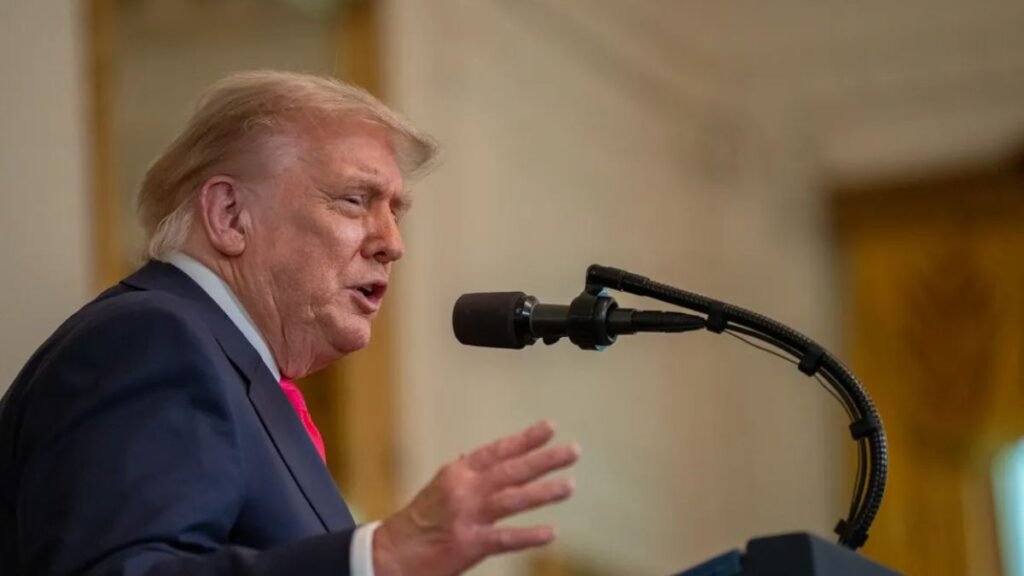President Donald Trump recently boasted before the European leaders in the White House that he had “done” (ended) six wars this year. On a different occasion, he remarked that the figure had risen to seven wars ended since his resumption in office this year. Since then, the subject of U.S. (non) violent intervention has come under debate. While U.S efforts were involved in these conflicts, whether they were instrumental to their resolution or not remains a subject of debate among commentators.
With some parties outrightly rejecting the notion of a U.S. effort in achieving peace or cessation of hostilities, while some resume hostilities before the ink dries up on the peace deals, this article seeks to interrogate Trump’s ‘war-ending’ tactics in these cases to unpack the reasons for their ineffectiveness.
THE ‘ENDED’ WARS
President Trump believes his involvement led to the cessation of hostilities in the following conflicts: Israel and Iran; the Democratic Republic of Congo and Rwanda; Cambodia and Thailand; India and Pakistan; Serbia and Kosovo; and Egypt and Ethiopia. The seventh war refers to the age-long conflict between Armenia and Azerbaijan, where both countries’ leaders recently signed a peace deal at the White House. A brief analogy of the conflicts and U.S. involvement tells a different story, which contradicts Trump’s position.
- Israel-Iran conflict: On June 13, Israel launched surprise attacks on Iranian military and nuclear facilities, killing prominent politicians, military leaders and nuclear scientists. Iran responded with a barrage of missiles and drone strikes against Israeli cities and military sites. However, the highlight of the conflict was the U.S missile strike at one of the nuclear facilities in Fordo. Since Israel’s major objective was to eliminate Iran’s nuclear capabilities, U.S. involvement was crucial to bomb the heavily reinforced facilities, which Israeli strikes could not incapacitate. After nearly 10 days of conflict, both countries agreed to a ceasefire mediated by the U.S. and Qatar on June 24. While experts believe that Trump’s decision to bomb Iran likely ended the conflict quickly, it is still difficult to determine how much influence he had in the mediation.
- Democratic Republic of Congo-Rwanda conflict: On June 27, the U.S. and Qatar facilitated a peace deal between the Democratic Republic of Congo (DRC) and Rwanda, which culminated in the Washington Accord, which was signed in the White House by representatives from both countries. The agreement involves several critical areas, including the call for respect to each country’s territorial integrity and the cessation of hostilities, facilitation of the return of refugees and internally displaced persons (IDPs) alongside guaranteed humanitarian access, among others. President Trump publicly claimed credit for this deal, asserting his administration’s efforts in bringing the warring sides to the table. However, conflicts have since resumed from both sides, irrespective of the Accord and the follow-up negotiations in Doha.
- Cambodia–Thailand conflict: Both countries agreed to a ceasefire after armed conflicts arose from a territorial dispute on July 24, which resulted in the deaths of dozens of casualties and over 300,000 people displaced. The countries agreed to a ceasefire deal on July 28 following U.S.-backed talks and President Trump’s earlier decision not to engage in trade talks with either of the countries until the hostilities ceased.
- India–Pakistan conflict: The two nuclear-armed countries were involved in heightened military strikes after India launched missile strikes on Pakistan in a military campaign codenamed “Operation Sindoor”. The strikes followed India’s accusation of Pakistan supporting and harbouring the terrorists who carried out the Pahalgam terrorist attacks in India-administered Jammu and Kashmir, which resulted in the death of 26 civilians. Both leaders agreed to a ceasefire on May 10, with President Trump adding that the deal was reached after long night talks mediated by the U.S. While the Pakistan Prime Minister, Shehbaz Sharif, appreciated President Trump for his “leadership and proactive” role in putting an end to the hostilities, their counterparts from India disputed President Trump’s role in achieving the ceasefire on different occasions.
- Kosovo and Serbia: I mean, even I didn’t know this one. But Trump stated on June 27 that Kosovo and Serbia were “getting ready to go to war” with each other before he intervened. While Kosovo’s President, Vjosa Osmani, backed up Trump’s claims, the Serbian President, Aleksandar Vučić, rebuffed this while adding that “it does not even occur to us…(we have) not engaged any soldiers, we have not moved any machinery.”
- Egypt-Ethiopia conflict: The issue goes back to President Trump’s first term in office. Egypt and Sudan state that the construction of the Ethiopian Renaissance Dam, which was completed recently, could rob them of their share of the water from the River Nile. Though Trump failed to broker a deal between the parties, he assured that he was “going to get it solved”, after Egypt’s foreign minister noted that negotiations had yielded no concrete outcomes. According to Trump, he remarked that “I think if I’m Egypt, I want to have water in the Nile and we’re working on that one, it’s a problem, but it’s going to get solved,” adding that “It’s a very important source of income and life, it’s the life of Egypt, and to take that away is pretty incredible. But we think we are going to have that solved very quickly.” While this statement has been positively received by the Egyptian President, Ethiopian officials and experts warn that it undermines Ethiopia’s right to use its natural resources, adding that the remark risks escalating a delicate situation. Some of these experts have also accused Trump of favouring Egypt’s interests over Ethiopia’s interests in this matter, referring to his (President Trump) remarks in 2020 following Ethiopia’s insistence on constructing the dam, thus rejecting the deal brokered for them by President Trump.
- Armenia and Azerbaijan conflict: On August 8, President Trump hosted the leaders of both countries, where they signed a U.S.-brokered deal to reopen transport routes across the South Caucasus. The conflict between the two countries, which dates to the Soviet Union era, is over the control of Nagorno-Karabakh, which led to war in the 1990s and reignited violent conflicts in 2020. As of 2023, Azerbaijan has full control over the disputed conclave. In addition to reopening the transport routes, the deal also grants the U.S. development rights to what the White House dubs the “Trump Route for International Peace and Prosperity”, which is a new corridor linking Azerbaijan to its exclave of Nakhchivan. Irrespective of this ‘peace deal’, deep division remains between both parties as Azerbaijan still occupies parts of Armenia; the border between the two countries is still closed, and diplomatic ties remain frozen.
In summary, of all seven ‘wars’ President Trump claims to have stopped, only the Thailand-Cambodia conflict was attributed to U.S. efforts, while other conflicts remain either largely unresolved or the U.S efforts in resolving the conflicts remain doubtful.
WHAT IS WRONG WITH PRESIDENT TRUMP’S TACTICS?
A lot of diplomatic efforts go into conflict resolution between states. As the leader of the free world, the U.S. remains in a strategic position to lead mediation efforts towards resolving violent conflicts and maintaining global peace and order. So, what’s changed in Trump’s era? Why have his tactics failed to usher in the expected results in most of the cases above, and in extension to other global conflicts? A few suggestions come to mind.
- Prioritised U.S. interests: ‘Strategic peace making’ remains a key issue hindering the effective resolution of conflicts. This is because of powerful states like the U.S. lean towards short-term gains over long-lasting peace. Typical examples include choosing what conflict (and how) to intervene in (as seen in the Israel-Gaza conflict), seeking personal national gains as ‘compensation’ for mediation efforts (as seen in Ukraine, DRC-Rwanda conflict, Armenia-Azerbaijan conflict, etc.), and generally being involved only in conflicts that soothe U.S. influence or interests.
- Controlled narrative: Whether it is for the optics or to further U.S interests, the urge of the Trump presidency to swiftly take credit for bringing an end to a conflict remains an issue in the conflict resolution mechanism. One of the dangers of this attitude is its denigration of the efforts of other mediators, including local officials and experts from both warring parties who have worked tirelessly behind the scenes to usher in a peaceful resolution of the conflict. In reaction, more states may be forced to take credit for their efforts, like Indian officials have done during the India-Pakistan conflict.
- Global solutions, local blind spots: One poorly noted tactic of the Trump administration is the resolution of a conflict without recourse to the local drivers of the conflict. A typical example is the recent DRC-Rwanda peace deal, where leaders of both countries were brought in for a U.S.-brokered peace deal, whereas the M23 rebels, who are key non-state actors in this conflict, were not involved in the process. It is no wonder that the deal fell through, as hostilities have since resumed from both sides.
- Divestment from the international human rights principle: The notion of prioritising peace without justice and recourse to international human rights principles remains a stumbling block in the pursuit of long-lasting peace. Just like in the Egypt-Ethiopia conflict above, the U.S. refusal to acknowledge Ethiopia’s right to utilise its natural resources, and the border situation in Armenia and Azerbaijan, among others, trading justice and human rights for strategic political gains will offer short-term respite and push the parties further away from achieving complete resolution of the conflict and usher in long-lasting peace.
- Dwindling U.S. influence: With the rollout of U.S. tariffs targeting both allies and non-allies and the absence of critical bodies like the United States Agency for International Development (USAID), states have begun to build their resilience while preparing for a life without U.S. support or influence. The downside here is that the U.S. is quickly losing its ‘political pull’ to easily and swiftly resolve conflicts involving these states. The presence of USAID, for instance, offering critical humanitarian services in conflict areas, will give the U.S the leverage and local support to mediate in such disputes.
CONCLUSION
President Trump’s approach to conflict resolution highlights the limitations of a strategy that prioritises optics over substance and short-term gains over sustainable peace. While the U.S. still commands a unique position to steer negotiations and influence warring parties, Trump’s tactics highlight the risks of pursuing peace without inclusivity, justice, or attention to local realities.
By prioritising U.S. gains, claiming disproportionate credit, and neglecting the human rights dimension of conflicts, the administration undercut its ability to foster trust and durable outcomes. What emerges from these “ended wars” is not a legacy of successful peacemaking, but rather a cautionary tale of how great-power mediation can falter when diplomacy is reduced to spectacle. If anything, the Trump era underscores the need for a recalibration of U.S. conflict resolution strategies, away from transactional diplomacy and toward genuine, locally anchored solutions that embrace justice, inclusivity, and shared responsibility for peace.
Read More: Opinion: Shared Past, Fractured Present: Re-evaluating South Asian Regionalism
Disclaimer: The opinions expressed in this article are solely those of the author and do not necessarily represent the views of The Ink Post. While every effort is made to ensure accuracy, readers are encouraged to verify information independently before forming conclusions.



